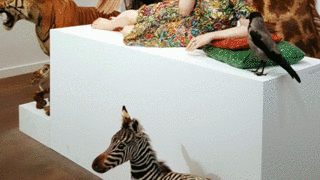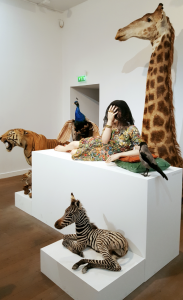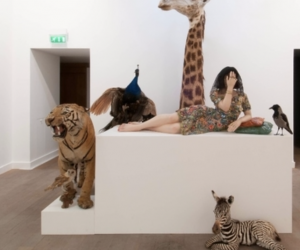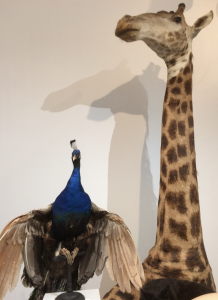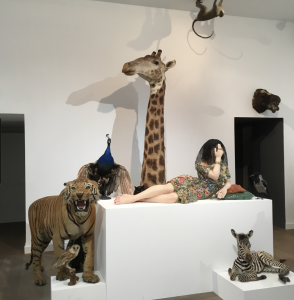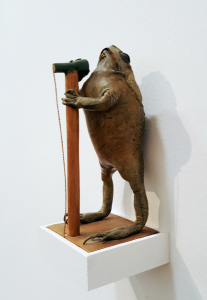Sophie Calle, a French photographer, writer, conceptual and installation artist was born on the 9th of October, 1953. Her work often revolves around the theme of loss, death, vulnerability, intimacy, and mourning the past. Her work has been exposed in a variety of places such as Paris, Russia, New York, Belgium, Brazil, London, and the Netherlands. Her pieces have been greatly influenced by the loss of her father, Bob Caller, an oncologist.
The artwork that intrigued me most is an installation that Calle has worked on with a friend, Serena Carone, who sculpted her in 2000, in France. Throughout this work, a plaster version of herself is surrounded by different animals, as she imagines what her tomb would eventually look like: A green monkey, a dog, a Taurus, a cat, a zebra, a toad, a peacock, a Cornell, a giraffe, and most importantly, a tiger that represents her father: ‘Bob, Mon Pere, Le Tigre, Parce Que C’Etait Mon Pere’ says Calle as she describes the piece. Each animal has a sad story that justifies their deaths. In a way, by making the stories so real, viewers confuse whether to her, animals were real human beings. This work is exposed on a large white block (or even a table) facing a white wall; in which a life size plaster version of the artist is laying down. Calle is surrounded by life size artificial animals, that also seem very real, which creates confusion within the viewer. The lighting plays a big role in this accurate (human-size) display: As the superficial light hanging from the ceiling is projected on the animals, it creates a shadow on the white wall. At this point, do the shadows represent the juxtaposition of life and death? She is imagining/ creating her tomb; however, she is still alive. This intention Is portrayed within the use of light. Through this work, by relaying stories of sickness, heartbreaks, and sad stories concerning the deaths of the animals, viewer interpret that she is trying to comfort herself regarding her father, and her cat’s deaths. What she is trying to do is find reasons to why people die, in order to accept the fact that the ones she loved most have passed away. When she creates her tomb, she is surrounded by a cat, as well as a tiger who she claims represents her father. This justifies that this work of art is made for her to feel hopeful. She hopes to be reunited with her loved ones later on.
The reason to why I chose this specific art piece would be because I have approached a class project in a very similar way. For the Pere Lachaise Tour, my group and I took the initiative to imagine and create our own tombs. The biggest challenge I faced within that idea was to put aside my personal feelings, desires, and beliefs. However, now that I look at this art work by Sophie Calle, and see how she openly talks about how she would like to be buried, with no shame of people’s judgments, I feel inspired and cannot stop myself from doing the same. I question and think of how I would like to be buried, having lost very close relatives. For some reason, this installation also gave me hope, maybe in the end, I am not the only one who wishes for an afterlife in which we are all reunited with our loved ones.
If I had to criticize this work, I would comment and change its display. The work was placed at the end/ corner of the first floor. It seemed quite isolated from the story/text/ explanation Sophie Calle wrote regarding her art work. At first, I did not make the connection between the writing and the piece. Therefore, I would probably decrease the amount of art pieces in the room, and place it by itself facing a large white wall with its text near it. As for the lighting, I would keep it as is since it clearly represents the juxtaposition of life ad deaths as she creates her tomb, alive.
